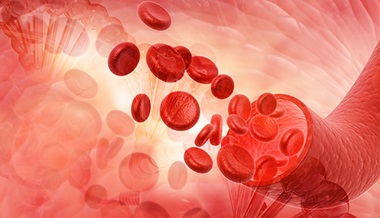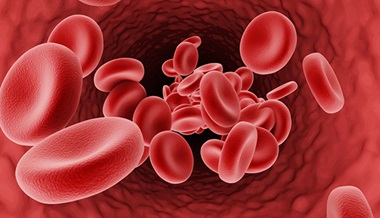Iron-Deficiency Anemia
What is iron-deficiency anemia?
The most common cause of anemia worldwide is iron deficiency. Iron is needed to form hemoglobin, part of red blood cells that carry oxygen and remove carbon dioxide (a waste product) from the body. Iron is mostly stored in the body in the hemoglobin. About one-third of iron is also stored as ferritin and hemosiderin in the bone marrow, spleen, and liver.
What causes iron-deficiency anemia?
Iron-deficiency anemia may be caused by the following:
-
Diets low in iron. Iron is obtained from foods in our diet; however, only 1 mg of iron is absorbed for every 10 to 20 mg of iron ingested. A person unable to have a balanced iron-rich diet may suffer from some degree of iron-deficiency anemia.
-
Body changes. An increased iron requirement and increased red blood cell production is required when the body is going through changes, such as growth spurts in children and adolescents, or during pregnancy and lactation.
-
Gastrointestinal tract abnormalities. Malabsorption of iron is common after some forms of gastrointestinal surgeries. Most of the iron taken in by foods is absorbed in the upper small intestine. Any abnormalities in the gastrointestinal (GI) tract could alter iron absorption and result in iron-deficiency anemia. Surgery or medications that stop stomach acid production will also decrease iron absorption.
-
Blood loss. Loss of blood can cause a decrease of iron and result in iron-deficiency anemia. Sources of blood loss may include GI bleeding, menstrual bleeding, or injury.
What are the symptoms of iron-deficiency anemia?
The following are the most common symptoms of iron-deficiency anemia. However, each individual may experience symptoms differently. Symptoms may include:
-
Abnormal paleness or lack of color of the skin
-
Irritability
-
Lack of energy or tiring easily (fatigue)
-
Increased heart rate (tachycardia)
-
Sore or swollen tongue
-
Enlarged spleen
-
A desire to eat peculiar substances such as dirt or ice (a condition called pica)
The symptoms of iron-deficiency anemia may resemble other blood conditions or medical problems. Always consult your doctor for a diagnosis.
How is iron-deficiency anemia diagnosed?
Iron-deficiency anemia may be suspected from general findings on a complete medical history and physical examination, such as complaints of tiring easily, abnormal paleness or lack of color of the skin, or a fast heartbeat (tachycardia). Iron-deficiency anemia is usually discovered during a medical examination through a blood test that measures the amount of hemoglobin (number of red blood cells) present, and the amount of iron in the blood. In addition to a complete medical history and physical examination, diagnostic procedures for iron-deficiency anemia may include the following:
-
Additional blood tests for iron
-
Bone marrow aspiration and/or biopsy. A procedure that involves taking a small amount of bone marrow fluid (aspiration) and/or solid bone marrow tissue (called a core biopsy), usually from the hip bones, to be examined for the number, size, and maturity of blood cells and/or abnormal cells. This test is usually not necessary.
-
Upper and/or lower endoscopy. These tests may help rule out a source of blood loss.
Treatment for iron-deficiency anemia
Specific treatment for iron-deficiency anemia will be determined by your doctor based on:
-
Your age, overall health, and medical history
-
Extent of the anemia
-
Cause of the anemia
-
Your tolerance for specific medications, procedures, or therapies
-
Expectations for the course of the anemia
-
Your opinion or preference
Treatment may include:
-
Iron-rich diet. Eating a diet with iron-rich foods can help treat iron-deficiency anemia. Good sources of iron include the following:
-
Meats, such as beef, pork, lamb, liver, and other organ meats
-
Poultry, such as chicken, duck, turkey, (especially dark meat), liver
-
Fish, such as shellfish, including clams, mussels, and oysters, sardines, anchovies
-
Leafy greens of the cabbage family, such as broccoli, kale, turnip greens, and collards
-
Legumes, such as lima beans and green peas; dry beans and peas, such as pinto beans, black-eyed peas, and canned baked beans
-
Yeast-leavened whole-wheat bread and rolls
-
Iron-enriched white bread, pasta, rice, and cereals
-
-
Iron supplements. Iron supplements can be taken over several months to increase iron levels in the blood. Iron supplements can cause irritation of the stomach and discoloration of bowel movements. They should be taken on an empty stomach, or with orange juice, to increase absorption. They are much more effective than dietary interventions alone. In cases of malabsorption or intolerance, IV iron may be needed.
-
Evaluation for a source of blood loss. This may include upper endoscopy or colonoscopy.
How does the body process iron?
Iron is present in many foods and absorbed into the body through the stomach. During this process of absorption, oxygen combines with iron and is transported into the plasma portion of blood by binding to transferrin. From there, iron and transferrin are used in the production of hemoglobin, stored in the liver, spleen, and bone marrow, and utilized as needed by all body cells.
The following is a list of foods that are good sources of iron. Always consult your doctor regarding the recommended daily iron requirements for your particular situation.
| Iron-Rich Foods | Quantity |
Approximate Iron Content (milligrams) |
|---|---|---|
| Oysters | 3 ounces | 13.2 |
| Beef liver | 3 ounces | 7.5 |
| Prune juice | 1/2 cup | 5.2 |
| Clams | 2 ounces | 4.2 |
| Walnuts | 1/2 cup | 3.75 |
| Ground beef | 3 ounces | 3.0 |
| Chickpeas | 1/2 cup | 3.0 |
| Bran flakes | 1/2 cup | 2.8 |
| Pork roast | 3 ounces | 2.7 |
| Cashew nuts | 1/2 cup | 2.65 |
| Shrimp | 3 ounces | 2.6 |
| Raisins | 1/2 cup | 2.55 |
| Sardines | 3 ounces | 2.5 |
| Spinach | 1/2 cup | 2.4 |
| Lima beans | 1/2 cup | 2.3 |
| Kidney beans | 1/2 cup | 2.2 |
| Turkey, dark meat | 3 ounces | 2.0 |
| Prunes | 1/2 cup | 1.9 |
|
Roast beef |
3 ounces | 1.8 |
| Green peas | 1/2 cup | 1.5 |
| Peanuts | 1/2 cup | 1.5 |
| Potato | 1 | 1.1 |
| Sweet potato | 1/2 cup | 1.0 |
| Green beans | 1/2 cup | 1.0 |
| Egg | 1 | 1.0 |





